Finally, I have separated the coupler from the end of my prop shaft! It took some doing; let me explain.
Before:

After:

Ultimately, I need to re-attach/re-bed my prop shaft support strut; and I wanted to replace the hose on my stuffing box. But, to do those things, I needed to get the prop shaft out of the way, which required removing the coupler. The set screws were rusted solid with the coupler, so after struggling unsuccessfully for a bit with various wrenches, I cut one of the screws off and started drilling it out, and drilling, and drilling, and drilling...
Well, this stuff is hard, and I guess I just don't have a lot of patience (nor a lot of experience drilling in hard metal -- I'm sure my technique is all wrong). In the meantime, I had acquired some special miracle "Rust Buster" and I bought an impact tool. Working with those things, I was able to unscrew the other set screw from the coupler (the one that I had not cut off yet), without too much trouble. But the one I had cut off and started drilling was still in there. I tried an ez-out on it with no luck, so I went back to the tool store for yet another cobalt drill bit and kept at it. Eventually, I had drilled out most of the screw, not all the way into the dimple, but below the level of the shaft based on my crude depth gauging. I hoped that if any part of the screw hadn't been drilled out and was standing proud, that it would just shear off when I started to drive the coupler off.
So I set to work at that, using an old 1/2" clevis pin as the spacer and some longer bolts. A little heat on the coupler, some penetrating oil, tighten the bolts with breaker bars, repeat. It was on hard, but by golly it started moving! I had to swap out the spacers and bolts a couple of times to go the distance, and the further out it got, the easier it went. Finally it was off! Great!
I went down outside the boat to pull the shaft out the back, but it wouldn't come. Hmmmm.. it's hanging up on something. So I went back up to check, and there on the shaft was a little burr of metal standing proud, dragged down from the set screw dimple. It had gouged a path for itself through the coupler! (No wonder it was so hard driving it off the shaft!)
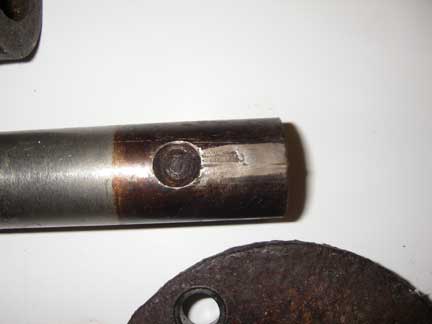
The burr after I ground it down so it would slip through the stuffing box.
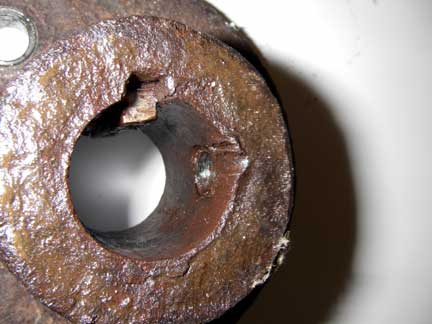
The gouge it plowed in the coupler.
I ground the burr down with my Dremel, and the shaft came out fine. I pulled the stuffing box off the shaft log, and gave it all a good once over. There was definite groove worn in the shaft by the stuffing, and there were some gouges in the shaft where it lies in the cutlass bearing, which can't be good. I guess it's time for a new shaft...

All the pieces layed out more or less in proper relation to one another.
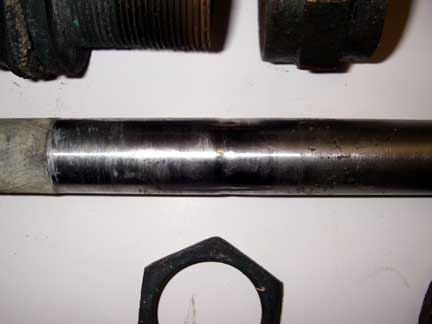
The groove worn in the shaft at the stuffing box.
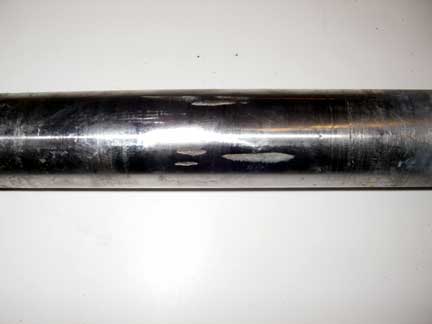
Gouges in the shaft where it passes through the cutlass bearing.
When I put it all back together, I would like to insert a Drivesaver or similar (it seems that the Yanmar equivalent that Tim L. would recommend is about 1/2 the price!), but I don't know if I've got enough room between the coupler and the stuffing box as they were (see Before picture above). Moving the coupler back (and shortening the shaft) by an inch would leave only about an inch or so between the packing nut and the coupler, which doesn't give one a whole lot of room for picking out the old flax or placing new stuff when the time comes for that. I suppose I could try moving the engine forward an inch. It could use new mounts, anyways. Then I'll need a new length of exhaust hose to reach the waterlift muffler. Does it ever end? (rhetorical question, you don't need to answer that!)
Alternatively, I could shorten the hose between the stuffing box and the shaft log/stern tube -- there appears to be an inch plus of space there. What do you think? How much clearance is needed between the end of the stuffing box and the shaft log/stern tube?
Here's a shot looking at the back of the engine. You can see I've ripped out the engine box walls:
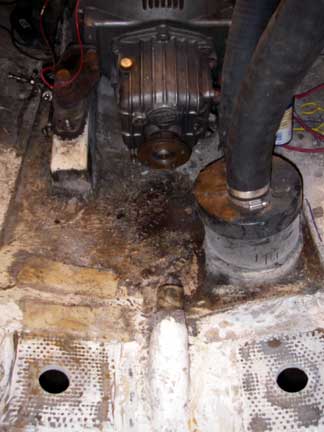
Just for fun, heres a view down the shaft log/stern tube from the transmission:
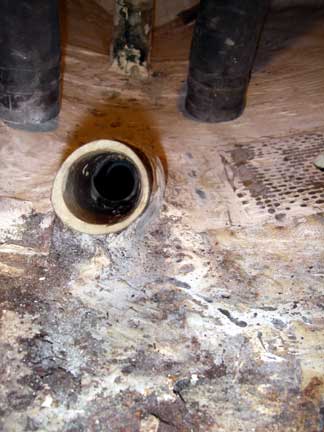
And here's a side view of my shaft log/stern tube:
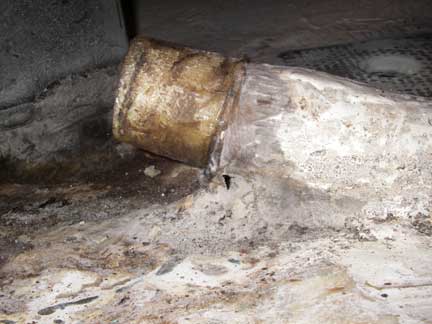
And finally, here's what's left of the 1/2" clevis pin I started with as push rod spacer for driving the shaft out of my coupler:
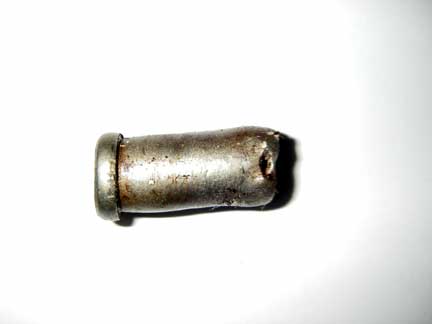
Next, I'll be tackling the shaft support strut, as first presented here.
Any feedback welcome....
Thanks,